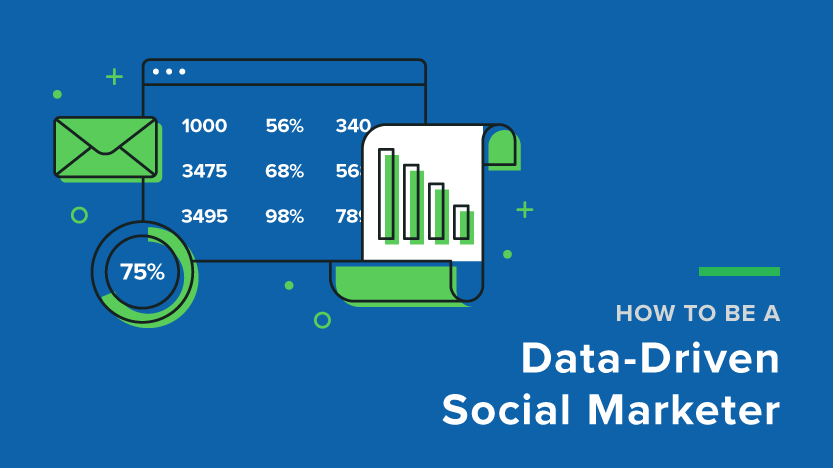
How to Be a Data-Driven Social Marketer
There’s no brand like your brand.
While you can look to other brands in your industry and beyond for content inspiration, and even scope out what your biggest competitors are doing, the most reliable way to make sure your social activities are driving results and connecting with your audience is to look at the data specific to your own brand.
Here’s how to be a data-driven social marketer, whether you need a refresher or don’t know where to begin.
1. Get Historical
What have been your most successful campaigns and posts to date as a brand?

What are the commonalities in your most successful content? Do they come in the form of…
- Seasons/events: Such as a time of year, conference, promotion
- The content of your content: For instance, if you are a cookware brand, posts including recipes vs. posts that include influencers? Content labeling is a great tool to use for this.
- Content type: Short-form video vs. long-form video vs. photos vs. carousels vs…
- Specific messaging: Which messages have resonated best with your audience in the past, all-up?
And where are your most successful posts/campaigns focused in the funnel?
- Awareness: They are focused on getting likely buyers to know more about your brand and/or product offering(s)
- Consideration: They are focused on getting people who already know/follow/have interacted with your brand to consider buying your product
- Decision: They are focused on driving web visits, form fills, and/or sales.
- Adoption: They are focused on continuing to engage people who already are customers
- Advocacy: They are focused on getting current customers to let their friends know about your brand and its offerings. Which, of course, cycles back to awareness.
The ideal social strategy includes a mix of all these, but knowing in which category you find the most success will show you where to focus the majority of your efforts.
Finally, put together an editorial calendar which incorporates all the content pillars which have been successful for you in the past.
2. Set Clear Goals and Track Progress Regularly
Set clear goals now, with KPI’s. If you don’t know how, use this social metrics map.

Make yourself accountable. Schedule a quarterly review meeting for social, where you’ll show your results.
Track your progress regularly. Briefly looking at your progress towards goal first thing in the morning. This will ensure that you don’t lose sight of your goals and the tweaks you need to make to your social strategy to get there. What you prioritize will flourish. Prioritize the data, and you’re prioritizing results.
3. Identify Your Target Audience Today
Your target audience is constantly changing. What they want to see from brands and what they care about is constantly changing.

Do you have a clear picture of who your target audience on social is today?
- Age: Which age ranges are most involved in the conversation around your key topics/themes?
- Location: Where does this audience mostly live? When should you be posting content, and should you have a global-local strategy?
- Life stages: Are they getting married? Having kids? Not getting married? Not having kids? Leveling up in their careers? Just entering the workforce? This is all relevant information, whether you are a B2B or B2C brand. You want the fullest picture possible of your audience.
- Where are they at in the funnel? Where in the funnel does most of the conversation seem to be focused?
- Behaviors: What is your audience doing/talking about doing on social?
- Where are they spending their time? Which social channels should you be most focused on?
Use a listening solution to find out.
4. Testing Is Everything
Here’s the bad news: not everything you try on social is going to work, even if you’re a data geek. But, if you’re afraid to fail, you won’t try new things. New features come out all the time. Test them! They may work and may not work. That is okay.
Test the same message on multiple platforms; test varying visual elements; test different product shots; test sound vs. no sound for videos; test different captions; test different CTA’s.
If you’d like a primer on social testing, check out this handy guide.
5. Build a Campaign Performance Template
This is an easily modifiable tool that you can use over and over again to present your results and explain to key stakeholders what you’ll be doing differently next time around. It should include:
- Goals and KPI’s: What were your goals and KPI’s at the beginning of the time period?
- Here’s what happened: Here are the campaigns we put out, and how they performed individually. Include examples of social audience reaction.
- Here’s how we performed to goal: Include your highest performing pieces of content.
- Here’s what we will change moving forward: This is where you include key learnings and action items.
This doesn’t have to be a long deck, but it should include data in context—not data for data’s sake.
Want to get your hands on the most in-depth data around for your own brand? Request a demo below.





